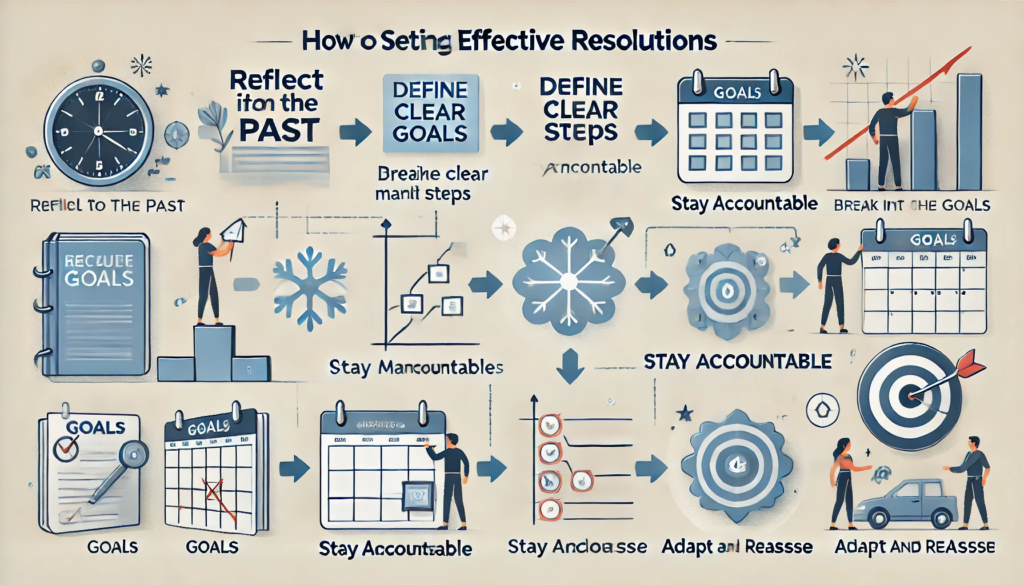Key Takeaways
- Reflect on the Past to Inform Future Goals: Analyze past successes and setbacks to create resolutions rooted in experience and realistic expectations.
- Set Clear, Specific, and Manageable Goals: Break down your resolutions into actionable steps and measurable milestones to maintain focus and motivation.
- Adapt and Stay Accountable: Regularly reassess your progress, adjust strategies as needed, and leverage accountability tools or support systems for long-term success.
Setting resolutions is a timeless tradition that symbolizes hope, renewal, and the desire for growth.
Whether it’s improving your health, advancing in your career, or nurturing personal relationships, resolutions provide a structured pathway to transform aspirations into reality.
However, as inspiring as the concept may be, statistics show that a significant majority of people abandon their resolutions within the first few months.
This common trend raises an important question: How can you set resolutions that not only stick but also drive meaningful progress in your life?

The answer lies in a well-thought-out, step-by-step approach to creating and managing your resolutions.
Setting effective resolutions isn’t about writing down a list of lofty goals; it’s about understanding what truly matters to you, defining actionable steps, and maintaining the discipline to follow through.
By adopting proven strategies and avoiding common pitfalls, you can dramatically increase your chances of success.
This comprehensive guide will take you through a systematic process to craft resolutions that are clear, achievable, and impactful.
We’ll delve into why reflection is a critical starting point, how to set goals that align with your values, and the importance of accountability and adaptability in achieving them.
You’ll also discover practical tips, proven techniques, and examples to help you navigate the challenges and celebrate the wins along the way.
Whether you’ve struggled to keep past resolutions or are looking to fine-tune your goal-setting approach, this blog will provide you with the tools and insights to make your resolutions a powerful catalyst for personal and professional growth.
Let’s embark on this journey together and turn your aspirations into lasting achievements.
Understanding the Purpose of Resolutions
Resolutions are more than just wishful thinking or fleeting New Year’s traditions—they are a structured framework for personal and professional growth.
Understanding the purpose of resolutions is crucial to crafting goals that are not only meaningful but also achievable. Below, we explore what resolutions are, why they matter, and the benefits they offer, with practical examples to illustrate their impact.
What Are Resolutions and Why Do They Matter?
- Defining Resolutions:
- Resolutions are commitments to achieve specific goals or improve particular areas of life.
- They differ from aspirations, which are broader desires without concrete plans.
- Example: Resolving to “read one book per month” is actionable, whereas aspiring to “be more knowledgeable” lacks specificity.
- The Role of Resolutions in Personal Development:
- Provide clarity and focus by setting clear targets.
- Act as a roadmap for achieving long-term objectives.
- Example: A resolution to “save $5,000 by year-end” can serve as a stepping stone toward buying a house or starting a business.
- Resolutions as Motivation Drivers:
- Inspire individuals to take purposeful actions.
- Help maintain momentum even during challenging times by reminding individuals of their ultimate goals.
Benefits of Setting Resolutions
- Increased Self-Awareness:
- Encourages reflection on strengths, weaknesses, and areas for improvement.
- Example: Identifying that procrastination affects productivity can lead to setting a resolution to “use a task management tool daily.”
- Improved Focus and Direction:
- Helps prioritize what truly matters amidst competing demands.
- Example: A professional resolution to “enhance leadership skills through training” ensures focus on career advancement.
- Enhanced Motivation:
- Tangible goals make it easier to stay motivated and track progress.
- Example: Tracking the achievement of running 5 km weekly boosts confidence and encourages consistency.
- Accountability:
- Writing down resolutions or sharing them with others adds a layer of commitment.
- Example: Telling a friend about your resolution to “quit smoking by June” can provide external encouragement.
- Opportunity for Personal Growth:
- Setting and achieving resolutions fosters a sense of accomplishment.
- Example: Successfully learning a new skill, such as coding, can open doors to career opportunities.
Examples of the Purposeful Impact of Resolutions
- Physical Health:
- Resolution: “Exercise three times a week to improve stamina.”
- Impact: Better overall health, reduced stress, and a more active lifestyle.
- Financial Goals:
- Resolution: “Create a monthly budget and save 20% of income.”
- Impact: Greater financial stability and reduced stress over unexpected expenses.
- Professional Growth:
- Resolution: “Enroll in an online certification course by March.”
- Impact: Skill enhancement, making you more competitive in your industry.
- Improved Relationships:
- Resolution: “Schedule a weekly call with family or close friends.”
- Impact: Strengthened bonds and better emotional well-being.
Why Understanding the Purpose Enhances Success
- Aligns Resolutions with Values:
- Goals that resonate with your core values are more likely to be pursued consistently.
- Example: Someone passionate about sustainability might resolve to “reduce single-use plastics by 50% this year.”
- Prevents Overcommitment:
- Clarifying the purpose helps prioritize meaningful resolutions over trivial or overly ambitious goals.
- Example: Instead of resolving to “learn five new skills,” focusing on one skill, like public speaking, ensures deeper mastery.
- Creates a Positive Mindset:
- Knowing why a resolution matters fuels determination and resilience.
- Example: Understanding that regular exercise reduces the risk of chronic illnesses can keep you motivated to hit the gym.
By grasping the purpose behind resolutions, individuals can approach goal-setting with clarity and intention. This foundational understanding lays the groundwork for creating resolutions that truly align with personal aspirations and life priorities, setting the stage for meaningful and lasting change.
Before we venture further into this article, we would like to share who we are and what we do.
About 9cv9
9cv9 is a business tech startup based in Singapore and Asia, with a strong presence all over the world.
With over nine years of startup and business experience, and being highly involved in connecting with thousands of companies and startups, the 9cv9 team has listed some important learning points in this overview of How to Set Effective Resolutions.
If your company needs recruitment and headhunting services to hire top-quality employees, you can use 9cv9 headhunting and recruitment services to hire top talents and candidates. Find out more here, or send over an email to [email protected].
Or just post 1 free job posting here at 9cv9 Hiring Portal in under 10 minutes.
How to Set Effective Resolutions: A Step-by-Step Guide
- Reflect on the Past
- Define Clear and Specific Goals
- Break Resolutions into Manageable Steps
- Stay Accountable
- Adapt and Reassess
1. Reflect on the Past
Reflection is the cornerstone of effective goal-setting. By looking back on past experiences, achievements, and challenges, you gain valuable insights that guide future resolutions. This process allows you to build on your successes and address areas for improvement, ensuring your resolutions are both realistic and impactful. Below, we explore the importance of reflection, techniques to evaluate the past year, and examples to illustrate how to use this step effectively.
Why Reflection is Essential
- Provides Clarity:
- Helps identify what worked and what didn’t in previous resolutions or efforts.
- Offers a clearer understanding of personal strengths and limitations.
- Example: Realizing that a vague goal like “eat healthier” was ineffective compared to a specific plan such as “meal prep on Sundays.”
- Promotes Self-Awareness:
- Encourages honest evaluation of habits, routines, and behaviors.
- Reveals patterns that may hinder or support growth.
- Example: Recognizing that procrastination often derailed work deadlines.
- Sets the Foundation for Growth:
- Reflection ensures future goals are built on informed decisions rather than assumptions.
- It helps you avoid repeating mistakes and leverage past successes.
Techniques for Reflecting on the Past
Journaling
- Benefits of Journaling:
- A structured way to document thoughts, feelings, and outcomes.
- Provides a tangible record to review progress over time.
- How to Use Journaling for Reflection:
- Write about key accomplishments from the past year.
- Document challenges and how you responded to them.
- Identify recurring themes, such as time management struggles or successes in team projects.
SWOT Analysis (Strengths, Weaknesses, Opportunities, Threats)
- Why SWOT is Effective:
- A systematic way to evaluate internal and external factors influencing success.
- Highlights areas to improve and opportunities to seize.
- Steps to Perform a Personal SWOT Analysis:
- List your strengths: What did you excel at?
- Example: Successfully completing a fitness challenge shows discipline.
- Identify weaknesses: What held you back?
- Example: Lack of financial planning led to overspending.
- Recognize opportunities: What can you leverage for future growth?
- Example: Free online courses to enhance career skills.
- Pinpoint threats: What external factors posed challenges?
- Example: Job market uncertainties affecting career goals.
- List your strengths: What did you excel at?
Visualization
- Benefits of Visualization:
- Encourages a deep emotional connection to past experiences.
- Helps you see how far you’ve come and where you want to go.
- How to Practice Visualization:
- Close your eyes and mentally walk through significant events of the past year.
- Focus on what you felt during your achievements and setbacks.
- Example: Reflecting on the pride of delivering a successful presentation at work.
What to Reflect On
Achievements
- Why Celebrate Successes:
- Builds confidence and motivation for future resolutions.
- Reinforces the behaviors and strategies that worked well.
- Examples of Achievements to Reflect On:
- Professional: Receiving a promotion or completing a challenging project.
- Personal: Adopting a healthier lifestyle or learning a new skill.
Challenges and Lessons Learned
- Importance of Learning from Challenges:
- Helps you identify gaps in skills or resources.
- Teaches resilience and adaptability.
- Examples of Challenges and Takeaways:
- Missing a savings goal: Highlighted the need for a stricter budgeting system.
- Struggling to balance work and family: Emphasized the importance of time management.
Unfinished Goals
- Evaluating Unmet Goals:
- Determine whether they were unrealistic or simply lacked proper planning.
- Decide whether to carry them forward or replace them with new priorities.
- Examples of Unfinished Goals:
- Professional: “Complete a certification course” left incomplete due to time constraints.
- Personal: “Run a marathon” delayed due to insufficient training.
Turning Reflection Into Action
- Identify Key Takeaways:
- Summarize the main lessons from your reflection process.
- Use these insights as the foundation for setting new resolutions.
- Set the Stage for Planning:
- Categorize past experiences into strengths to build on and areas to improve.
- Example: If journaling revealed that lack of time management hindered progress, make it a priority resolution for the coming year.
By reflecting on the past, you gain clarity, self-awareness, and actionable insights that empower you to set resolutions with purpose. This step ensures your goals are rooted in experience, giving you the best chance of success as you move forward.
2. Define Clear and Specific Goals
Once you’ve reflected on the past, the next critical step is to define clear and specific goals. Vague aspirations are unlikely to lead to actionable results, while clearly defined objectives provide the structure and motivation needed for success. This section explores how to craft precise goals using proven techniques, highlights the importance of clarity, and offers practical examples to guide you.
Why Clear and Specific Goals Matter
- Provide Direction:
- Clearly defined goals act as a roadmap, eliminating ambiguity about what needs to be done.
- Example: A goal to “earn a professional certification by June” provides a clear focus compared to “advance in my career.”
- Enhance Motivation:
- Specificity creates a sense of purpose, making it easier to stay committed.
- Example: Knowing you aim to “save $5,000 by year-end for a vacation” is more motivating than a vague desire to “save money.”
- Facilitate Progress Tracking:
- Specific goals allow you to measure progress accurately.
- Example: Tracking weekly gym visits is easier with a goal to “exercise three times a week” rather than “get fit.”
Characteristics of Clear and Specific Goals
SMART Goals Framework
- Specific: Clearly state what you want to achieve.
- Example: Instead of “lose weight,” say “lose 10 pounds in three months.”
- Measurable: Include metrics to track progress.
- Example: A goal to “read 12 books this year” is measurable.
- Achievable: Ensure the goal is realistic within your resources and constraints.
- Example: “Run a 5K in three months” is realistic for a beginner, while “complete a marathon in a month” might not be.
- Relevant: Align goals with your broader aspirations and values.
- Example: If your career focus is leadership, “improve public speaking skills” is highly relevant.
- Time-Bound: Set a deadline to create urgency.
- Example: “Save $1,000 by March 31” provides a clear timeframe.
Steps to Define Clear and Specific Goals
Break Down Large Goals
- Why It Helps:
- Dividing goals into smaller steps makes them less overwhelming and easier to achieve.
- Example: Instead of “write a book,” break it into steps like “write one chapter per month.”
- How to Do It:
- Identify the end goal and list smaller milestones.
- Set deadlines for each milestone.
- Example: If the goal is “run a marathon,” milestones might include:
- Week 1-4: Run 5 km consistently.
- Week 5-8: Increase to 10 km.
- Week 9-12: Complete a half marathon.
Use Action-Oriented Language
- Benefits of Action-Oriented Goals:
- Encourages active steps rather than passive aspirations.
- Example: Replace “be healthier” with “prepare three home-cooked meals per week.”
- Examples of Action-Oriented Goals:
- Personal: “Practice mindfulness meditation for 10 minutes daily.”
- Professional: “Deliver three presentations at work this quarter.”
Prioritize Goals
- Why Prioritization is Key:
- Focusing on too many goals at once can dilute your efforts.
- Example: If both health and career are priorities, start with one resolution in each area, like “exercise thrice weekly” and “complete a leadership course.”
- Steps to Prioritize:
- Rank goals based on importance and urgency.
- Focus on goals with the highest impact.
Examples of Clear and Specific Goals
Health and Fitness Goals
- “Walk 10,000 steps daily for six months to improve overall fitness.”
- “Lose 15 pounds in four months by following a balanced diet and exercising thrice weekly.”
Financial Goals
- “Save $200 monthly to build an emergency fund of $2,400 by year-end.”
- “Pay off $5,000 in credit card debt within 12 months by allocating 20% of monthly income.”
Personal Development Goals
- “Learn basic conversational French by completing a language course within six months.”
- “Read 20 books in a year by dedicating 30 minutes daily to reading.”
Career Goals
- “Secure a promotion within 12 months by completing a professional certification course and taking on leadership roles at work.”
- “Expand professional network by attending one industry conference per quarter.”
Tips for Staying Committed to Specific Goals
- Visualize Success:
- Create a vision board or write down how achieving the goal will improve your life.
- Example: Visualizing a healthier you can reinforce the goal of “exercising four times weekly.”
- Use Technology for Tracking:
- Leverage apps or tools to monitor progress.
- Example: Use budgeting apps to track savings goals or fitness trackers to monitor workout routines.
- Seek Accountability:
- Share your goals with a friend or join a group with similar objectives.
- Example: A friend who shares your goal of “running a 5K” can help keep you accountable.
By defining clear and specific goals, you set a strong foundation for success. This step ensures that your resolutions are actionable, measurable, and aligned with your aspirations, significantly increasing your chances of achieving them.
3. Break Resolutions into Manageable Steps
Breaking resolutions into smaller, manageable steps is crucial for staying motivated and ensuring steady progress. Large goals can feel overwhelming, but dividing them into actionable tasks provides clarity and makes them more achievable. This section explains why breaking resolutions into steps is effective, offers practical strategies, and provides examples to guide you.
Importance of Breaking Resolutions into Steps
- Prevents Overwhelm:
- Tackling a significant goal all at once can feel daunting, leading to procrastination.
- Example: Instead of aiming to “get in shape,” break it into specific actions like exercising thrice a week, eating healthy, and staying hydrated.
- Provides a Clear Path:
- Steps serve as milestones, showing progress and keeping you on track.
- Example: Writing a novel becomes manageable when broken down into “write 500 words daily” or “complete one chapter per month.”
- Boosts Motivation:
- Completing smaller tasks creates a sense of achievement, motivating you to continue.
- Example: If your goal is to run a marathon, completing a 5K first boosts confidence for the next stage.
Strategies for Breaking Resolutions into Manageable Steps
Identify the End Goal
- Why It’s Important:
- Clearly understanding your end goal helps you determine the steps needed to achieve it.
- Example: For the resolution “start a business,” the end goal might be launching a website and acquiring the first five clients.
- How to Define the End Goal:
- Write a detailed description of what success looks like.
- Example: “By December, I want a fully operational e-commerce store with 10 products and monthly sales of $1,000.”
Break Down into Phases
- What Are Phases?
- Grouping steps into broader phases makes the process organized and logical.
- Example: Preparing for a Half Marathon
- Phase 1: Build endurance by running three times a week.
- Phase 2: Gradually increase distance every two weeks.
- Phase 3: Practice a full-length run a month before the race.
Create Actionable Tasks
- Characteristics of Actionable Tasks:
- Specific, measurable, and tied to a timeline.
- Example: Replace “get healthier” with “prepare two home-cooked meals this week” or “drink eight glasses of water daily.”
- Steps to Create Tasks:
- Start with the broad goal, e.g., “learn a new skill.”
- Divide it into steps:
- Research courses online.
- Enroll in a program within two weeks.
- Dedicate one hour daily to study.
Set Deadlines for Each Step
- Why Deadlines Matter:
- Deadlines create urgency and prevent procrastination.
- Example: Improving Career Skills
- Goal: “Enhance public speaking skills.”
- Steps:
- Week 1-2: Join a public speaking class.
- Week 3-6: Practice speeches weekly.
- Week 7: Deliver a presentation at a local event.
Examples of Breaking Down Common Resolutions
Financial Goals
- Goal: “Save $10,000 in a year.”
- Break it into monthly savings targets of $833.
- Identify actionable steps:
- Create a budget by week 1.
- Cut discretionary spending (e.g., eating out) by 10% starting week 2.
- Automate monthly transfers to a savings account.
Health Goals
- Goal: “Lose 20 pounds in six months.”
- Break it into bi-weekly targets of 3-4 pounds.
- Actionable steps:
- First two weeks: Replace sugary drinks with water and walk 30 minutes daily.
- Weeks 3-6: Incorporate strength training thrice weekly.
- Weeks 7-12: Follow a balanced meal plan and increase workout intensity.
Personal Development Goals
- Goal: “Learn a new language in a year.”
- Divide into levels: Basic, Intermediate, Advanced.
- Actionable steps:
- Months 1-3: Learn basic vocabulary and grammar.
- Months 4-6: Practice conversational skills.
- Months 7-12: Engage in real-world conversations or online exchanges.
Tips for Staying on Track
Monitor Progress
- Why Monitor Progress?
- Helps identify areas of improvement and celebrate milestones.
- Example: Use a fitness tracker for health goals or a budgeting app for financial goals.
- How to Track Progress:
- Keep a journal or digital tracker.
- Review achievements weekly or monthly.
Adjust Steps as Needed
- Be Flexible:
- Unexpected challenges may require adapting your plan.
- Example: If your goal is to “read 12 books in a year” and you fall behind, switch to shorter books or audiobooks to catch up.
Celebrate Small Wins
- Importance of Celebrating Milestones:
- Recognizing achievements keeps motivation high.
- Example: Reward yourself after completing a significant step, such as buying workout gear after a month of consistent exercise.
By breaking resolutions into manageable steps, you create a clear path to success. Each small achievement builds momentum, making even the most ambitious goals feel attainable. This approach ensures you stay focused, motivated, and on track toward achieving your aspirations.
4. Stay Accountable
Accountability is a crucial element in achieving resolutions. It ensures you remain committed and focused, providing the motivation to follow through with your goals. Staying accountable can involve seeking support from others, using tools to track progress, or cultivating self-discipline. This section will explore strategies to maintain accountability, with examples to illustrate their effectiveness.
Why Accountability is Important
- Encourages Consistency:
- Regularly checking your progress ensures you stay on track.
- Example: If you aim to exercise daily, having a workout buddy can help you stick to the schedule.
- Boosts Motivation:
- Knowing someone is monitoring your progress or that you’re tracking your own success pushes you to perform better.
- Example: Sharing your weight loss journey on social media can inspire you to stick to your goals.
- Promotes Self-Awareness:
- Reflecting on your actions helps you recognize areas where you need to improve.
- Example: If you’re saving for a vacation, tracking expenses can highlight unnecessary spending.
Strategies to Stay Accountable
Share Your Goals with Others
- Involve Friends and Family:
- Sharing your resolutions with close ones creates a support system.
- Example: If your goal is to quit smoking, inform your friends so they can encourage and remind you.
- Join a Community or Group:
- Find like-minded individuals working toward similar goals.
- Example: Join an online community for writers if your resolution is to complete a novel.
Set Up Accountability Partners
- Choose Reliable Partners:
- Find someone who will encourage and challenge you to stay on track.
- Example: Partner with a coworker to meet professional development goals.
- Regular Check-Ins:
- Schedule weekly or monthly reviews with your accountability partner.
- Example: If your resolution is to learn a new skill, discuss your progress and challenges with your partner.
Use Technology to Track Progress
- Productivity Apps:
- Use apps like Trello, Asana, or Habitica to organize tasks and monitor progress.
- Example: Set daily reminders to drink water if improving hydration is your goal.
- Health and Fitness Trackers:
- Devices like Fitbits or apps like MyFitnessPal can help track health-related resolutions.
- Example: Monitor daily steps if your goal is to walk 10,000 steps a day.
Maintain a Goal Journal
- Why Journaling Helps:
- Writing down your goals and progress fosters commitment and clarity.
- How to Use a Journal:
- Record daily or weekly updates on your progress.
- Example: For a financial resolution, note your savings, expenses, and adjustments each week.
Examples of Accountability in Practice
Professional Goals
- Goal: “Earn a professional certification.”
- Share your goal with a mentor or manager.
- Schedule weekly study sessions with colleagues.
- Use a task tracker to outline study materials and deadlines.
Health Goals
- Goal: “Run a marathon in six months.”
- Join a local running club for motivation and support.
- Use a fitness app to track your runs and share progress with friends.
- Sign up for mini-races to prepare for the big event.
Personal Development Goals
- Goal: “Read 12 books in a year.”
- Join a book club or an online reading group.
- Use Goodreads to track your reading list and update progress.
- Share book reviews on social media to engage with others.
Tips for Staying Accountable Long-Term
Create Incentives
- Reward Yourself for Milestones:
- Example: After completing a month of consistent exercise, treat yourself to new workout gear.
- Tie Goals to Personal Values:
- Link your resolutions to things that matter to you, such as family or career growth.
- Example: Learning a new language to connect better with relatives abroad.
Embrace Transparency
- Be Honest with Yourself:
- Acknowledge when you fall behind and adjust your plan as needed.
- Example: If you skip a few workouts, recommit to your schedule and set realistic targets.
- Track Progress Publicly:
- Share updates on social media or within a group for added motivation.
- Example: Post monthly progress photos if your goal is fitness-related.
Reflect and Reassess
- Evaluate Your Journey:
- Periodically review your progress and adjust your approach.
- Example: If your goal is career advancement, reassess your skills and make improvements based on feedback.
- Learn from Challenges:
- View setbacks as opportunities for growth.
- Example: If saving money is difficult, analyze spending habits and identify areas to cut back.
By staying accountable, you reinforce your commitment to your resolutions and increase the likelihood of success. Whether it’s sharing your goals, leveraging technology, or maintaining self-discipline, these strategies ensure you stay on track and make steady progress toward your aspirations.
5. Adapt and Reassess
Adapting and reassessing resolutions is essential for long-term success. Life is dynamic, and circumstances often change, requiring flexibility and adjustments to stay aligned with your goals. This step ensures your resolutions remain relevant, achievable, and aligned with your evolving priorities. Below, we’ll explore actionable strategies, supported by examples, to help you adapt and reassess effectively.
Why Adaptation and Reassessment Are Necessary
Maintaining Relevance
- Life Changes:
- Personal or professional circumstances can shift unexpectedly, necessitating goal adjustments.
- Example: A new job may require revising your resolution to spend more time with family.
- Evolving Priorities:
- Goals set at the beginning of the year might lose significance over time.
- Example: If your resolution was to travel more, financial constraints might prompt you to focus on local adventures instead.
Enhancing Achievability
- Recognizing Over-ambition:
- Unrealistic goals can lead to burnout or discouragement.
- Example: If your resolution was to write a book in six months, you might revise it to complete a detailed outline and a few chapters.
- Learning from Progress:
- Tracking your progress can reveal what works and what doesn’t.
- Example: If daily workouts are unsustainable, consider switching to three sessions per week.
Strategies for Effective Adaptation and Reassessment
Regularly Review Your Progress
- Set Milestone Checkpoints:
- Break your resolution timeline into smaller segments for periodic reviews.
- Example: Assess quarterly achievements for a goal like saving $10,000 in a year.
- Evaluate Metrics:
- Use measurable indicators to determine if you’re on track.
- Example: For a resolution to eat healthier, monitor calorie intake or track the number of home-cooked meals.
- Celebrate Successes:
- Acknowledge milestones to stay motivated.
- Example: Treat yourself to a movie night after successfully following a budget plan for two months.
Identify Obstacles
- Pinpoint Challenges:
- Reflect on factors hindering your progress.
- Example: If your resolution is to learn a new skill but time is an issue, identify activities you can deprioritize.
- Address Roadblocks:
- Develop solutions to overcome obstacles.
- Example: If consistent study sessions are challenging, try shorter but more frequent learning intervals.
Make Adjustments to Goals
Refine Your Objectives
- Narrow Your Focus:
- Simplify complex goals into more specific tasks.
- Example: Instead of “improving health,” focus on “walking 10,000 steps daily” or “drinking eight glasses of water per day.”
- Adjust Timelines:
- Extend or shorten deadlines as needed to accommodate progress.
- Example: Postpone a resolution to launch a business by three months to complete market research.
Prioritize Flexibility
- Embrace Iteration:
- Be willing to modify your approach based on results.
- Example: If gym workouts aren’t appealing, switch to outdoor activities like hiking or cycling.
- Focus on What Matters:
- Reassess whether each resolution still aligns with your values and goals.
- Example: If professional certifications are no longer relevant to your career path, focus on developing other skills.
Seek Feedback and Support
Involve Accountability Partners
- Ask for Input:
- Discuss challenges and potential adjustments with trusted individuals.
- Example: A mentor might suggest alternative strategies to achieve a career-related goal.
- Collaborate on Solutions:
- Brainstorm ideas for overcoming obstacles together.
- Example: If family commitments interfere with evening workouts, your partner could help adjust household schedules.
Use External Resources
- Consult Experts:
- Seek advice from professionals in relevant fields.
- Example: A financial advisor could help refine a savings goal or suggest better investment strategies.
- Leverage Technology:
- Use apps or tools to analyze progress and suggest improvements.
- Example: A habit-tracking app might recommend revisiting goals you’ve marked incomplete multiple times.
Examples of Adaptation and Reassessment in Action
Career Goals
- Initial Goal: “Get promoted within one year.”
- Obstacle: Lack of specific skills required for promotion.
- Adaptation: Enroll in online courses to acquire skills and extend the timeline to 18 months.
Fitness Goals
- Initial Goal: “Run 5 km daily.”
- Obstacle: Knee pain after the first few weeks.
- Adaptation: Switch to low-impact activities like swimming or cycling and adjust the frequency to four times a week.
Financial Goals
- Initial Goal: “Save $1,000 per month.”
- Obstacle: Unexpected medical expenses.
- Adaptation: Revise the goal to $500 per month and plan to make up the difference later in the year.
Tips for Long-Term Adaptation
Stay Open-Minded
- Embrace Change:
- Accept that shifting goals is a natural part of growth.
- Example: Transitioning from a resolution to travel internationally to exploring local destinations during unforeseen global events.
- Experiment with Approaches:
- Try different methods to achieve your goals.
- Example: Shift from studying in the evening to early mornings if energy levels are higher.
Keep Learning
- Reflect on Lessons Learned:
- Use experiences to guide future resolutions.
- Example: If previous goals failed due to lack of time, set more manageable objectives next year.
- Stay Curious:
- Continuously seek information to refine your strategies.
- Example: Research new techniques for productivity to enhance work-related goals.
Adapting and reassessing resolutions ensures they remain practical and meaningful. By staying flexible, identifying challenges, and celebrating progress, you create a sustainable path to success, even when life takes unexpected turns.
6. Common Mistakes to Avoid
While setting resolutions is an exciting way to map out personal or professional growth, certain common mistakes can derail your journey. Recognizing and avoiding these pitfalls ensures that your goals remain realistic, achievable, and aligned with your long-term aspirations. This section outlines prevalent errors, practical examples, and strategies to prevent these mistakes.
Setting Unrealistic Goals
Overestimating Abilities or Resources
- Lack of Feasibility:
- Setting goals that are too ambitious without considering available resources.
- Example: Aiming to run a marathon within two months when you’ve never jogged before.
- Solution:
- Start small and progressively build on your capabilities.
- Example: Begin with a resolution to run 5 km consistently and gradually increase the distance.
Ignoring Time Constraints
- Misjudging Commitments:
- Overloading yourself with goals without accounting for your daily schedule.
- Example: Committing to attend a gym every day while managing a full-time job and family responsibilities.
- Solution:
- Prioritize one or two critical goals that fit into your lifestyle.
- Example: Opt for 30-minute home workouts if gym visits are time-consuming.
Lack of Specificity
Vague Objectives
- Generic Resolutions:
- Broad goals like “be healthier” or “improve finances” lack clarity and focus.
- Example: “Eat better” doesn’t specify which foods or habits need improvement.
- Solution:
- Define resolutions in measurable terms.
- Example: Replace “be healthier” with “eat five servings of vegetables daily.”
Unclear Success Metrics
- Difficulty Tracking Progress:
- Without benchmarks, it’s hard to determine whether you’re succeeding.
- Example: A goal to “learn coding” doesn’t specify whether you want to build an app or complete a course.
- Solution:
- Set clear criteria for achievement.
- Example: Specify “complete a Python certification course within six months.”
Neglecting a Plan of Action
Failure to Break Down Goals
- Overwhelmed by the Big Picture:
- Tackling a large goal without smaller milestones can lead to burnout.
- Example: Deciding to write a novel but struggling to start.
- Solution:
- Divide the goal into manageable steps.
- Example: Set weekly targets, such as writing 1,000 words or outlining a chapter.
Ignoring Potential Challenges
- Unprepared for Obstacles:
- Overlooking potential setbacks or resource gaps.
- Example: Planning to attend a daily yoga class without considering transportation issues.
- Solution:
- Anticipate challenges and develop contingency plans.
- Example: Have a backup option, like online yoga classes.
Lack of Accountability
Avoiding External Support
- Trying to Go Solo:
- Without sharing goals, it’s easier to abandon them unnoticed.
- Example: Resolving to quit smoking but not informing anyone about your decision.
- Solution:
- Involve others who can motivate and support you.
- Example: Join a group or inform friends and family about your resolution.
No Progress Monitoring
- Failing to Track Efforts:
- Without regular reviews, goals can fall to the wayside.
- Example: Deciding to save money but not tracking monthly expenses.
- Solution:
- Use tools or apps to monitor progress.
- Example: Track your savings using a budgeting app like Mint.
Impatience or Giving Up Too Soon
Unrealistic Expectations of Speed
- Expecting Immediate Results:
- Losing motivation when progress is slower than anticipated.
- Example: Quitting a resolution to lose weight after a month of minimal change.
- Solution:
- Understand that meaningful progress takes time.
- Example: Set incremental weight loss targets, such as 2 pounds per month.
Letting Small Setbacks Derail You
- All-or-Nothing Mentality:
- Abandoning goals entirely after minor failures.
- Example: Missing one study session and deciding to quit the resolution altogether.
- Solution:
- Embrace setbacks as learning opportunities.
- Example: If you miss a session, reschedule and recommit without guilt.
Overloading with Too Many Resolutions
Spreading Yourself Too Thin
- Lack of Focus:
- Pursuing multiple resolutions can dilute your effort and concentration.
- Example: Deciding to learn a new language, train for a marathon, and start a business simultaneously.
- Solution:
- Limit yourself to one or two primary resolutions.
- Example: Focus on starting the business first and add other goals later.
Unrealistic Multitasking
- Competing Priorities:
- Attempting to tackle unrelated goals simultaneously.
- Example: Balancing a fitness resolution with a resolution to read more books, leading to time conflicts.
- Solution:
- Sequence your goals based on importance and feasibility.
- Example: Focus on fitness for the first six months and shift to reading later.
Ignoring Mental and Emotional Well-being
Forgetting Self-Care
- Neglecting Balance:
- Pushing too hard without considering rest and recovery.
- Example: Sacrificing sleep to meet professional goals.
- Solution:
- Incorporate self-care into your resolutions.
- Example: Add “meditate for 10 minutes daily” as part of your routine.
Not Managing Stress
- Burnout Risk:
- Stress from pursuing goals can lead to abandoning them altogether.
- Example: Feeling overwhelmed by constant deadlines for a resolution.
- Solution:
- Include stress management strategies.
- Example: Practice deep breathing exercises or schedule regular breaks.
Examples of Common Mistakes and Solutions
Career Resolutions
- Mistake: Setting a goal like “become a manager” without understanding the skills required.
- Solution: Research the role, set learning milestones, and seek mentorship.
Health Resolutions
- Mistake: Aiming to lose 30 pounds in one month.
- Solution: Adopt a sustainable goal, like losing 1-2 pounds per week.
Financial Resolutions
- Mistake: Resolving to save a large amount without adjusting spending habits.
- Solution: Track expenses, cut unnecessary costs, and set smaller monthly savings goals.
Avoiding these common mistakes ensures your resolutions are not only well-structured but also more likely to succeed. By taking a thoughtful, realistic, and flexible approach, you’ll maximize your chances of achieving meaningful and sustainable change.
Conclusion
Setting effective resolutions is not merely about dreaming big; it’s about creating a structured pathway to turn aspirations into achievements. By following a step-by-step approach, you can transform your goals from abstract ideas into tangible realities. Whether you aim to enhance your personal growth, boost your career, improve relationships, or achieve financial stability, well-crafted resolutions can serve as a powerful tool to guide you toward a fulfilling future.
Recap of Key Steps to Success
- Reflect on the Past:
- Begin with introspection to understand your starting point and learn from prior experiences.
- Identify past successes, challenges, and lessons that can inform your new goals.
- Define Clear and Specific Goals:
- Create goals that are actionable, measurable, and tailored to your unique circumstances.
- Replace vague aspirations with focused objectives to ensure clarity and direction.
- Break Goals into Manageable Steps:
- Divide larger resolutions into smaller, achievable tasks.
- Celebrate incremental victories to maintain motivation and momentum.
- Stay Accountable:
- Share your resolutions with others, use tools to track progress, and establish a support system.
- Regularly review your efforts to ensure consistency and identify areas for improvement.
- Adapt and Reassess:
- Flexibility is key—adjust your approach based on changing circumstances or unexpected challenges.
- Treat setbacks as opportunities to refine your strategy and build resilience.
Avoiding Common Pitfalls
Achieving resolutions requires avoiding common mistakes that can undermine your efforts. Ensure your goals are realistic, specific, and supported by a clear plan of action. Avoid overloading yourself with too many objectives or neglecting self-care in the pursuit of progress.
For example:
- Instead of resolving to “read more,” specify a goal like “read one book per month.”
- Avoid committing to multiple unrelated resolutions simultaneously; prioritize what matters most.
Why Resolutions Matter
Effective resolutions are more than just a New Year’s ritual—they are a way to empower yourself to make meaningful changes. They:
- Encourage personal and professional growth.
- Provide a sense of purpose and direction.
- Help you build discipline, focus, and a growth-oriented mindset.
By setting resolutions thoughtfully, you can shape your life in ways that align with your values and long-term vision.
Final Encouragement
Remember, success with resolutions is not about perfection but persistence. Achieving meaningful change takes time, patience, and effort. Embrace the journey with an open mind, and don’t let minor setbacks discourage you. Every step, no matter how small, brings you closer to your goals.
Whether you’re embarking on a new career path, adopting healthier habits, or enhancing your relationships, the strategies outlined in this guide will equip you with the tools to succeed. Stay committed, adapt as needed, and celebrate each milestone along the way.
Call to Action
Now that you have a comprehensive framework to set effective resolutions, it’s time to take action. Reflect on your aspirations, create a clear plan, and start your journey toward a more purposeful and fulfilling life today. Share your resolutions with others, stay accountable, and remember: the path to success begins with a single step.
Empower yourself with well-crafted resolutions, and watch as your determination transforms your dreams into reality.
If you find this article useful, why not share it with your hiring manager and C-level suite friends and also leave a nice comment below?
We, at the 9cv9 Research Team, strive to bring the latest and most meaningful data, guides, and statistics to your doorstep.
To get access to top-quality guides, click over to 9cv9 Blog.
People Also Ask
What are the best ways to set effective resolutions?
To set effective resolutions, start by reflecting on past experiences, defining clear and specific goals, breaking them into manageable steps, staying accountable, and regularly reassessing your progress.
Why is reflecting on the past important for setting resolutions?
Reflecting on the past helps you understand what worked, what didn’t, and where improvement is needed. It provides valuable insights to create more realistic and achievable resolutions moving forward.
How do I create specific and clear resolutions?
To create specific resolutions, ensure they are actionable and measurable. Use the SMART goal framework (Specific, Measurable, Achievable, Relevant, Time-bound) to make them concrete and realistic.
What is the SMART goal framework for resolutions?
SMART stands for Specific, Measurable, Achievable, Relevant, and Time-bound. This framework helps you create clear, detailed, and realistic goals that are easier to track and achieve.
How do I break my resolutions into manageable steps?
Start by dividing large resolutions into smaller tasks. Focus on one small action at a time, setting deadlines for each. This makes the process less overwhelming and boosts motivation with each achievement.
How can I stay accountable to my resolutions?
You can stay accountable by sharing your goals with others, tracking progress with apps or journals, and setting regular check-ins with a friend, coach, or mentor to evaluate your progress.
What are the common mistakes people make when setting resolutions?
Common mistakes include setting vague or unrealistic goals, overloading yourself with too many resolutions, or neglecting accountability. It’s important to be specific, realistic, and focused on a few priorities.
How can I keep my resolutions realistic?
Keep your resolutions realistic by assessing your current lifestyle and resources. Set achievable goals that align with your abilities, and avoid setting expectations that might lead to disappointment.
What should I do if I feel overwhelmed by my resolutions?
If you feel overwhelmed, reassess your goals, break them down into smaller tasks, and focus on progress rather than perfection. Don’t hesitate to adjust timelines or seek support when needed.
How do I track my progress with resolutions?
Use apps, journals, or planners to track your progress. Regularly review your goals, noting completed tasks, and adjusting strategies as necessary. Tracking helps maintain motivation and ensures you’re on track.
How often should I reassess my resolutions?
Reassess your resolutions every few months to check progress. If things aren’t working, adapt your approach or adjust the goals to make them more achievable based on new insights or circumstances.
How do I stay motivated to achieve my resolutions?
Stay motivated by celebrating small milestones, keeping your resolutions visible, and surrounding yourself with supportive people. Reminding yourself of the reasons behind your goals can also reignite your drive.
What is the role of accountability partners in achieving resolutions?
Accountability partners help keep you on track by offering support, encouragement, and constructive feedback. Sharing your goals with someone adds an extra layer of responsibility and motivation.
Can I adjust my resolutions during the year?
Yes, it’s important to adapt resolutions as circumstances change. Flexibility ensures that you stay on course despite obstacles and continue working toward goals that remain relevant to you.
How can I overcome setbacks when working toward my resolutions?
Overcome setbacks by reframing challenges as learning experiences. Adjust your approach, stay persistent, and remind yourself that progress is about consistency, not perfection.
What are the benefits of setting resolutions for personal growth?
Setting resolutions for personal growth helps you focus on self-improvement, builds discipline, and promotes a sense of accomplishment. It guides your actions, creating meaningful and intentional progress in life.
How do I ensure my resolutions align with my long-term goals?
Ensure alignment by defining long-term goals first, then creating resolutions that serve as stepping stones toward those objectives. This ensures that each resolution is a meaningful part of your overall journey.
How can I balance multiple resolutions without feeling overwhelmed?
Prioritize resolutions based on importance and urgency. Focus on a few key goals at a time, breaking them into smaller steps to avoid burnout. Manage your energy and time to avoid overwhelming yourself.
What tools can I use to help set and achieve resolutions?
Tools like goal-setting apps, planners, habit trackers, and journals are great for setting and tracking progress. These tools can help you stay organized and motivated while breaking down goals into actionable tasks.
How do I know if my resolutions are achievable?
Resolutions are achievable if they align with your current capabilities and resources. Set small, measurable tasks to ensure your goals are within reach, adjusting timelines or expectations when necessary.
What should I do if I lose motivation halfway through the year?
Revisit the reasons behind your resolutions and evaluate progress. Adjust your approach if needed, set new milestones, and involve an accountability partner to reignite motivation and keep momentum.
How can I make my resolutions more meaningful?
Make resolutions meaningful by aligning them with your values and passions. When your resolutions reflect what truly matters to you, they become more motivating and easier to pursue long-term.
Is it okay to fail while working on resolutions?
Failure is a natural part of growth. Use setbacks as learning opportunities. Reflect, adapt your approach, and keep moving forward. Resilience and perseverance are key to long-term success.
How can I set resolutions for my career?
For career-related resolutions, focus on specific goals like skill development, networking, or career advancement. Break them down into actionable steps, such as attending workshops or seeking mentorship, and track progress over time.
How do I handle competing resolutions?
When you have competing resolutions, prioritize based on importance and feasibility. Focus on one resolution at a time or find ways to integrate them, such as combining fitness goals with stress management techniques.
What is the best way to stick with my New Year’s resolutions?
Stick with New Year’s resolutions by setting clear, achievable goals, breaking them into smaller steps, and tracking your progress regularly. Create accountability by sharing your resolutions with others.
How do I create a resolution plan that works?
A successful resolution plan includes specific, measurable goals broken into smaller steps, deadlines for each task, regular progress reviews, and flexibility to adapt as needed to stay on track.
Should I focus on one resolution or multiple at once?
It’s generally more effective to focus on one resolution at a time, especially if they are large or complex. Prioritizing your goals helps you concentrate your energy and avoid spreading yourself too thin.
How can I improve my self-discipline while pursuing resolutions?
Improve self-discipline by setting clear, small goals and tracking your progress. Build good habits, avoid distractions, and hold yourself accountable by sharing your goals or using reminders and rewards.
What if my resolution feels too difficult to achieve?
If a resolution feels too difficult, break it down further into smaller, more manageable steps. Reassess your approach and adjust timelines if needed. Remember, perseverance and small wins lead to success.
Can I use technology to help with my resolutions?
Yes, technology can assist with goal setting and tracking. Apps for habit tracking, time management, and fitness goals can help keep you organized and motivated, allowing for real-time progress monitoring.
How can I make sure my resolutions are aligned with my personal values?
Ensure your resolutions reflect your values by choosing goals that contribute to what’s most important to you. Regularly revisit these values and adjust your goals to maintain alignment with your core beliefs.
How do I deal with negative self-talk while working on resolutions?
Combat negative self-talk by reframing thoughts positively. Acknowledge setbacks without harsh judgment and focus on progress rather than perfection. Practice self-compassion and celebrate small achievements.
What is the importance of celebrating small wins in achieving resolutions?
Celebrating small wins boosts motivation and reinforces positive behavior. It provides a sense of accomplishment and encourages continued progress, helping to maintain momentum toward larger goals.































![Writing A Good CV [6 Tips To Improve Your CV] 6 Tips To Improve Your CV](https://blog.9cv9.com/wp-content/uploads/2020/06/2020-06-02-2-100x70.png)


